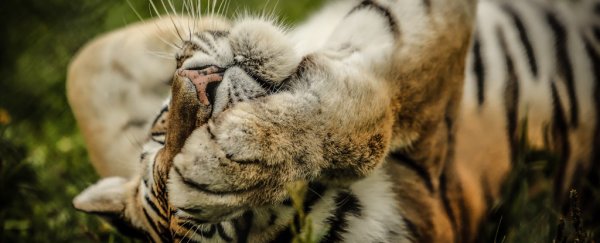It's a common question that experts say they get all the time: can big cats purr like household cats?
If only there was a simple response. Even though scientists have been debating the answer for well over a century, today the situation is far from clear.
From what we know so far, the answer centres around a bone in the cat's throat called the hyoid, which supports the larynx and tongue.
In small cats - like domestic cats, bobcats, lynxes, cheetahs and cougars - this bone is completely ossified and rigid. When the larynx vibrates, it can make the hyoid bone resonate, generating a low-frequency rumble that we call purring. Remarkably, this noise persists even when the cat breathes in and out.
In big cat species, however, the hyoid bone is only partly ossified, and this fundamentally changes what noises the animal can make.
Lions, tigers, leopards and jaguars have more flexible hyoid bones that are partly attached to the skull with an elastic ligament, and while these can produce deep and terrifying roars, they cannot, alas, produce purrs.
In the 19th century, a roar and a purr were deemed mutually exclusive, and cats were split up into two groups: those that could purr but not roar (small cats, felines) and those that could roar but not purr (big cats, pantherines).
While cheetahs and cougars are undoubtedly large cats in the colloquial sense, they are not scientifically classified as big cats because of their hyoid bones. They are, therefore, the largest of the small cats that can purr.
Or so we thought.
These days it appears that splitting cats up into those that can roar and those that can purr might have been too simplistic an approach. In a 2002 review, 20 out of 36 cat species were found to purr, including some big cats like lions and leopards.
In fact, scientists are still debating the results. Some claim that the sounds the lions and leopards made were not "true" purrs. They were only rolling, gurgling growls that sounded like purrs.
Others argue that lion and jaguar purrs were only evident on the exhale and not the inhale, and therefore, they cannot be the same thing.

All of this may sound extremely arbitrary, but the animal kingdom is heavily reliant on classification as a method of study. If lions and leopards make a fundamentally different noise to a household cat's purr, then they shouldn't be treated as the same kind of sound because they probably evolved differently.
So, according to present knowledge, "true" purring is established only in the families Felidae, which includes small cats, and Viverridae, a family of medium-sized mammals.
While big cats do make noises that sound similar, they seem incapable of purring in the true sense.
If we want to figure out what makes a "true" purr true, however, we need a closer inspection of cat species acoustics. And figuring out what's going on inside a cat's throat while it makes a noise is extremely difficult, not to mention dangerous.
So, while there's no clean answer to the purring question just yet, we do have some tantalising data - and scientists are likely to continue debating this subject for years to come. Hopefully nobody gets scratched in the process.
